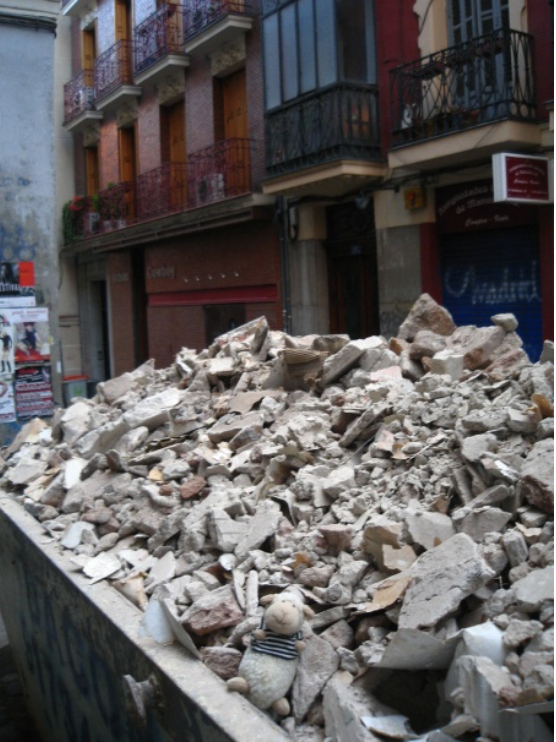Construction and Demolition (C&D) Waste
New CommercialWhat is Construction and Demolition (C&D) Waste?
Construction and demolition (C&D) waste consists of the debris generated during the construction, renovation, and demolition of buildings. C&D waste often contains bulky, heavy materials, such as concrete, wood, metals, glass, and salvaged building components.[1] Demolition accounts for more than 90% of C&D waste and construction represent less than 10%[2]; therefore, the concept of deconstruction is also essential to consider. Deconstruction is the practice of disassembling a building to salvage materials (joists, flooring, siding, fixtures) reused for new construction.[3] Carefully dismantling a structure with the intent of reusing materials extends the useful life of the material and requires less energy and raw materials and produces less pollution than discarding or even recycling materials.
The disposal of C&D waste contributes to environmental concerns including wasted materials and embodied energy, greenhouse gas generation, and other environmental impacts associated with producing new materials instead of using existing materials. Also, the number of C&D landfills is declining, which means fewer disposal options, greater hauling distances, and increased fuel consumption and vehicle emissions.[4] Many C&D waste materials can be reused on-site or elsewhere, or recycled (see Sustainable Materials, Source Reduction & Recycling).[5] Some materials may be toxic or classified as hazardous waste and require special handling and disposal.

Figure 1 – Dumpster with construction debris (source: Flickr – David d’O http://www.flickr.com/photos/david_o/534454633/sizes/l/in/photostream/)
How to Implement C&D Waste Reduction
Designing to prevent waste is an important first step in C&D waste management, accomplished by using standard sizes, advanced framing techniques, prefabrication, on-site protection of materials, and by returning unused materials to suppliers, among other strategies.[6] Make a plan and communicated clearly to the construction team specifying which items to reuse and which to recycle.
Important considerations for construction and demolition waste reduction include:[7]
- Design to prevent waste
- Know the waste stream (e.g., project waste materials, including hazardous materials)
- Become familiar with local ordinances and regulations
- Use specifications to set recycling goals and delineate responsibilities
- Require a construction waste management plan
- Educate project team about construction & demolition waste recycling goals
- Monitor waste management performance
Materials can be recycled onsite or offsite at a construction and demolition processor. Typical materials recycled from building sites include metal, lumber, asphalt, pavement, concrete, roofing material, corrugated cardboard, and wallboard.[8] There are many recycling centers in New Jersey for the scrap metal and corrugated cardboard generated by construction and demolition activities. Concrete, concrete block, asphalt, and brick are typically crushed and used as a substitute for quarry stone in road construction projects or used as a fill material in various applications. Decorative landscaping material use crushed brick and non-chemically treated and non-painted wood scrap, as well as tree stumps and tree trunks, are shredded and sold as landscaping mulch.
Planning is also essential for a successful deconstruction project. There are many steps to consider with deconstruction such as creating safety and materials management plans, surveying and taking inventory of the building materials, environmental health, and compliance, and coordinating with historic preservation designations.
Example
The Willow School – Gladstone, N.J.
According to the founder of The Willow School, the first LEED Gold Certified Building in NJ (2002), the project recycled over 85% of its construction waste. White pine trees removed during construction were sent to an NJ company to be milled and made into a wide variety of furniture. Built-in closets, bookshelves, chairs, and desks for students utilized salvaged white pine from the property.

Figure 2 – The Willow School (Source: Mark Biedron LEED AP, co-Founder)
Benefits
Benefits of reducing and recycling C&D waste:[9],[10]
- Conserves landfill space
- Reduces the release of methane (a potent greenhouse gas) from landfills
- Reduces the environmental impact of producing new materials
- Conserves natural resources
- Reduces overall project expenses through avoided purchase or disposal costs
- Creates jobs
- Deconstruction preserves architectural heritage by salvaging unique materials
Costs
EPA’s Recycling Economic Information (REI) report indicates that recycling and reuse of materials create jobs and generates local and state tax revenues. Out of the recycling categories, C&D materials recycling contributed the most in the areas considered: jobs, wage, and tax revenue.[11] Cost savings associated with C&D waste reduction reduces costs by avoiding the cost of disposal, potential revenue from the sale of recycled materials, and reductions in the need for waste disposal services.[12] Disposal fees are an expensive part of the demolition.
Depending on the building, deconstruction can salvage a large amount of material from a building and lead to savings on avoided disposal fees. Deconstruction typically requires more time and labor than traditional demolition but also provides more jobs and is an excellent opportunity for job training in the construction trades. The feasibility and cost-effectiveness of deconstruction are different for every building depending on a building’s construction and the material composition. Most wood-frame and some metal-frame buildings can apply deconstruction methods. The building components, their condition, and the method of attachment to the structure can affect the cost-effectiveness of salvaging materials. Deconstruction requires more labor for disassembly, removal, and sorting than conventional demolition. These costs can be balanced out with careful planning and accounting for the value of the salvaged building materials and the avoided cost of disposal.[13]
Resiliency
Many of the benefits listed above also contribute to resiliency. Reducing waste and reusing or recycling materials can help protect natural habitats that contribute to more resilient ecosystems. Established networks and markets for salvaged materials also help divert and reuse debris generated by natural disasters and severe storm events that can contaminate the environment following storm surges, flooding, and high winds.[14] Salvaging materials from storms turn recovery efforts into a profit-generating resource rather than a post-disaster clean-up expense.
[1] US EPA. Construction and Demolition Materials. http://www.epa.gov/wastes/conserve/rrr/imr/cdm/index.htm (accessed March 20, 2019).
[2] US EPA. Sustainable Management of Construction and Demolition Materials https://www.epa.gov/smm/sustainable-management-construction-and-demolition-materials#America (accessed March 20, 2019).
[3] BMRA. https://bmra.org/ (accessed March 23, 2019).
[4] Whole Building Design Guide. Construction Waste Management. http://www.wbdg.org/resources/cwmgmt.php (accessed March 23, 2019).
[5] Whole Building Design Guide. Construction Waste Management. http://www.wbdg.org/resources/cwmgmt.php (accessed March 20, 2019).
[6] Northeast Recycling Council. https://nerc.org/documents/moving_toward_zero_waste_cost_savings_a_roadmap_contractors_builders.pdf (accessed March 23, 2019).
[7] CalRecycle. C&D Recycling Toolkit for Contractors. https://www.calrecycle.ca.gov/ConDemo/Toolkit/ (accessed March 23, 2019).
[8] US EPA. Recover your Resources. https://www.epa.gov/brownfields/brownfields-recover-your-resources-reduce-reuse-and-recycle-construction-and-demolition (accessed March 23, 2019).
[9] Ibid.
[10] NYC DDC. http://www.nyc.gov/html/ddc/downloads/pdf/waste.pdf (accessed March 23, 2019).
[11] US EPA. Recycling Economic Information report. https://www.epa.gov/sites/production/files/2016-11/documents/final_2016_rei_report.pdf (accessed March 23, 2019).
[12] NJ DEP. The Economic Benefits of Recycling and Waste Reduction – Wastewise Case Studies from the Private and Public Sectors. https://www.state.nj.us/dep/dshw/recycling/wastewise/njwwcasestudy.pdf (accessed March 23, 2019).
[13] Seattle.gov. Salvage and Deconstruction. http://www.seattle.gov/util/forbusinesses/construction/cdwastemanagement/salvageanddeconstruction/ (accessed March 23, 2019).
[14] NJ DEP. (2015). Disaster Debris Management Planning Tool Kit for New Jersey Municipalities. http://www.nj.gov/dep/dshw/toolkit.pdf (accessed July 20, 2018).
Related Strategies
Resources
- Build it Green! NYC
- Building Materials Reuse Association
- City of New York Department of Design and Construction – Construction and Demolition Manual
- Construction and Demolition Recycling Association
- Habitat for Humanity Restore Directory – New Jersey
- Morris Habitat for Humanity – Deconstruction
- NJ DEP – The Economic Benefits of Recycling and Waste Reduction – Wastewise Case Studies from the Private and Public Sectors
- NJ DEP Solid & Hazardous Waste Program
- Northeast Recycling Council
- Northeast Recycling Council – Moving Toward Zero Waste & Cost Savings – A Roadmap for Builders and Contractors for Construction & Demolition Projects
- US EPA: Deconstruction and Reuse
- Whole Building Design Guide – Construction Waste Management Database
- Zero Waste Design Guidelines
